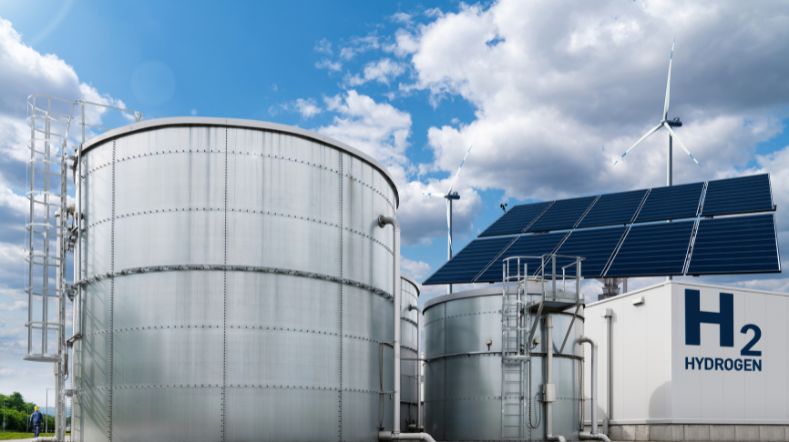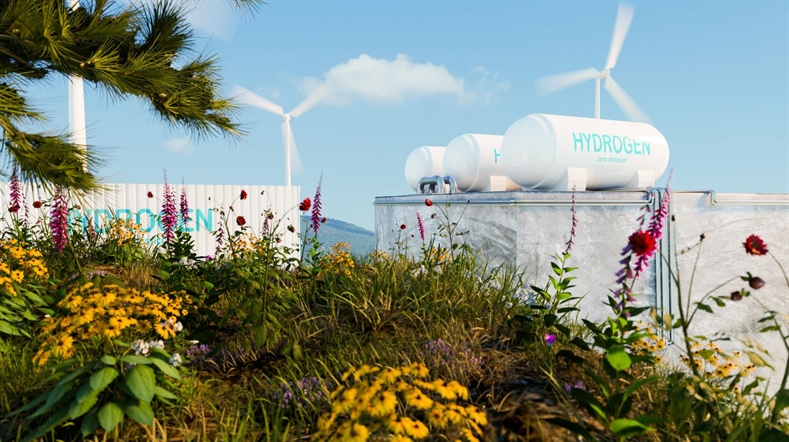Underground hydrogen storage: a crucial link in the energy transition
Green hydrogen is going to play a key role in our future energy supply. Because the production of green hydrogen, using electricity from renewable sources like wind and solar, and its demand are variable, large-scale underground hydrogen storage will be necessary. At TNO we conduct research and develop technology to safely and responsibly store hydrogen in the subsurface, in storage of salt caverns and depleted gas fields. Its commercial application is already coming into view.
Buffer between supply and demand
To make hydrogen widely applicable, it is necessary to develop all parts of the hydrogen chain simultaneously and in conjunction. This includes its sustainable production, transport, storage, and use. In this value chain, underground storage provides the essential buffer for matching supply and demand at time intervals of hours up to several months.
When green hydrogen production exceeds demand, the storage is filled. And if demand exceeds production, or if imports come to a halt, stored hydrogen can be used to meet the demand. This guarantees the security of supply that users need to switch to green hydrogen.
Storage in salt caverns and gas reservoirs underground
Given the large volumes of hydrogen involved, underground storage is needed to supplement limited above-ground storage. Two promising technologies are underground storage in salt caverns and in gas reservoirs. Salt caverns are cavities in underground salt formations created by salt mining.
Gas reservoirs are porous sandstone formations from which natural gas has been extracted. In both cases, hydrogen gas can replace the extracted rock salt or natural gas. In this way, we are making good use of available subsurface space for hydrogen storage, and can minimize land use at the surface.
To enable underground storage, we are investigating the physical and societal challenges of underground hydrogen storage in salt caverns and gas reservoirs. The goal of the Netherlands is to commercialise hydrogen storage in salt caverns by 2030. The development time for hydrogen storage in gas reservoirs is longer as this option needs to be tested in a demonstration project first before it can be scaled up.
Physical challenges
We have decades of experience with storing gas in salt caverns and gas reservoirs, as this is how natural gas is stored. But hydrogen molecules behave differently from natural gas molecules. A key difference is that hydrogen is a nutrient for micro-organisms. The question, therefore, is to what extent the micro-organisms will consume the injected and stored pure hydrogen and convert it into other substances.
This would affect storage performance, as some of the hydrogen could get lost and the remaining hydrogen could get contaminated by unwanted substances. Another research question is whether the materials used for storage will remain intact long enough. Storage sites are used for about 50 to 60 years. How do you measure whether all the materials will remain intact and how do you prevent their durability from being compromised? Finally, there are some remaining questions about the risks and impacts of underground hydrogen storage, like for example leakage, and what measures and methods can be used to mitigate and monitor them.

'The technological development of underground hydrogen storage must go hand in hand with the societal side. Consider legislation and public support, for example.'
Societal embedding
Remco Groenenberg is in charge of TNO’s research programme on underground hydrogen storage. This programme is not just about addressing technical challenges, Remco explains: 'The technological development of underground hydrogen storage must go hand in hand with the societal side. Consider legislation and public support, for example. If you ignore them, progress comes to a standstill.'
International collaboration
Globally, underground hydrogen storage is a key technology in the transition to renewable energy. Serge van Gessel, senior adviser at the Geological Survey of the Netherlands (GDN), part of TNO, coordinates a task on underground hydrogen storage within the Hydrogen Technology Collaboration Programme of the International Energy Agency programme.
'This programme task brings together the latest insights from recent research on underground hydrogen storage. The value of the programme is that we’re collaborating internationally with more than 50 parties with a diverse background – universities, industrial partners, and public authorities. We’ll publish the final report with our findings at the end of 2024.’
From laboratory to practice
Ongoing laboratory studies and modelling are giving us a clearer picture of the technical challenges of underground hydrogen storage. The next step is to test and verify these findings and insights on a larger scale. To this end, we are working with partners on the European project EUH2STARS to demonstrate underground storage of hydrogen into a small gas field in Austria.
TNO is involved in several work streams of this project:
- risk management
- the design of the subsurface and above-ground parts of the storage facility
- the integration of the storage facility into the transport system to balance supply and demand
- social embedding and acceptance.
Remco: ‘We at TNO have been at the forefront of development of methods, models and techniques being used in this project, and will learn a lot about their use and value for a future demonstration project in the Netherlands. TNO is advising the Dutch government on policies to exploit the potential of green hydrogen. The results of this demonstration in Austria are vital to this.’
Making innovation applicable
In addition to research, applying innovation and providing public information on the subsurface, TNO Geological Survey of the Netherlands has a formal role to advise the Dutch government on activities in the deep-subsurface such as underground hydrogen storage. To develop the required knowledge, we partner with many national and international organisations. These include governmental bodies, research institutes, universities, and industry partners.
TNO often has a leading role in these partnerships. 'Orchestrating innovation is part of our mission for a reason', Remco continues. 'As a large organisation with in-house knowledge on all relevant domains, TNO is ideally positioned to take the lead. We look at the whole chain, while many organizations specialise in specific parts. This is also true for underground hydrogen storage.'

'TNO itself is not directly responsible for realising underground storage; that is industry’s role. As an independent knowledge partner, we provide the knowledge for this.'
Serge: 'TNO itself is not directly responsible for realising underground storage; that is industry’s role. As an independent knowledge partner, we provide the knowledge for this.'
For example, we contributed to a Gasunie research project with generic insights in the risks of hydrogen storage in salt caverns. Such knowledge is crucial for preparing the implementation and upscaling of this technology in 2030 and beyond. Another good example is GroenvermogenNL, a National Growth Fund project investigating the green hydrogen value chain.
This project includes the HyTROS project, in which dozens of partners, led by TNO, are answering the remaining questions about hydrogen transport and storage in preparation for pilots and demonstration projects.
We also coordinated an EU-funded project that investigated the feasibility and potential of large-scale storage of green hydrogen in porous reservoirs in Europe. Thanks to the accompanying roadmap for the further development of underground hydrogen storage, its actual application is on the horizon.
Get inspired
Hydrogen in the energy system: The future of sustainable energy in the Netherlands and Europe


NORCE and TNO are entering into a strategic partnership on hydrogen developments


Dutch consortium participates in EU research project on large-scale hydrogen storage in depleted gas fields


Collaboration TNO and Elcogen for development Solid Oxide Electrification Technology in Europe


TNO explores PFAS alternatives with European partners



